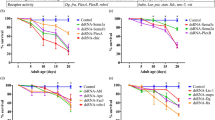Abstract
The peripheral sensory system of the Drosophila adult has been used for the genetic analysis of axon guidance because of its accessibility for experimental manipulation and mutant screens. Wing, leg, antenna, or eye sensory axons are able to pathfind normally under different perturbations, indicating that sensory axon guidance is a highly canalized process. Similarly to other model systems, sensory growth cones seem to use multiple, simultaneous cues for guidance. In addition, sensory axons from peripheral structures seem to be capable of using alternative substrates for pathfinding. Developmental regulation could account for the high stability of axon guidance under experimental and natural perturbation conditions. Despite this flexibility, functional characterization of genes involved in sensory axon guidance is being carried out in situations where there appears to be less system redundancy.
Similar content being viewed by others
Author information
Authors and Affiliations
Rights and permissions
About this article
Cite this article
García-Alonso, L. Postembryonic sensory axon guidance in Drosophila. CMLS, Cell. Mol. Life Sci. 55, 1386–1398 (1999). https://doi.org/10.1007/s000180050379
Published:
Issue Date:
DOI: https://doi.org/10.1007/s000180050379




